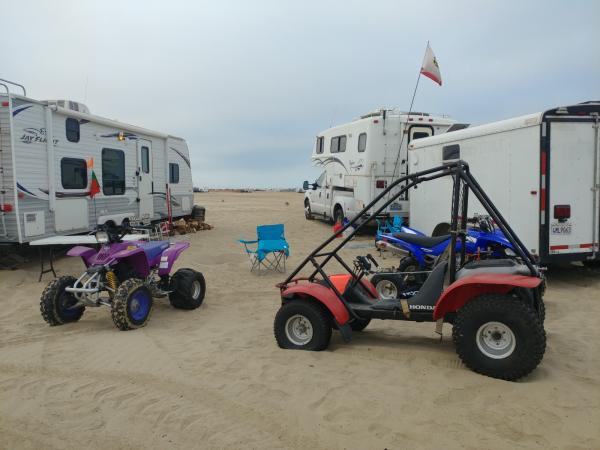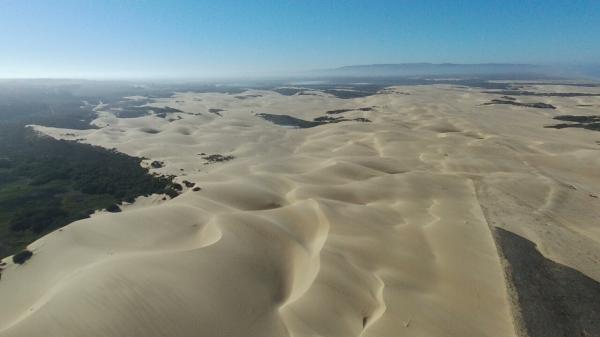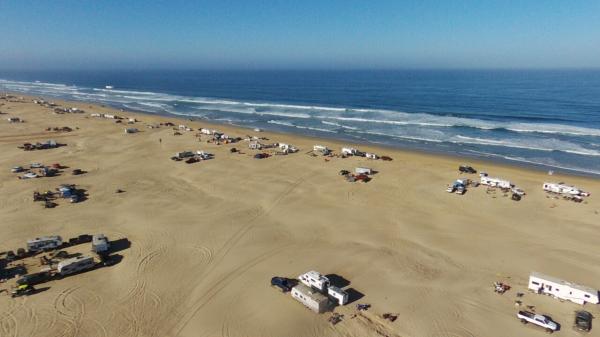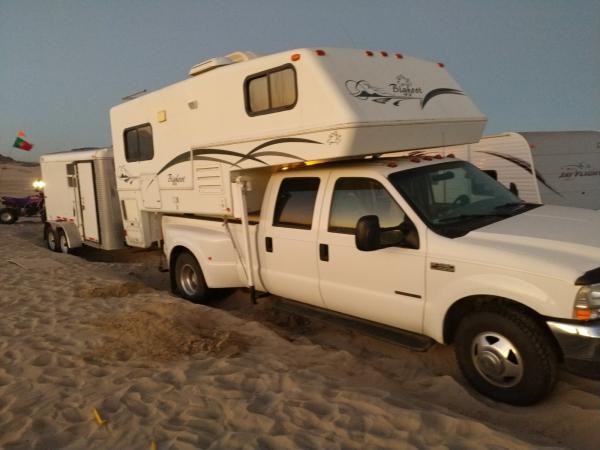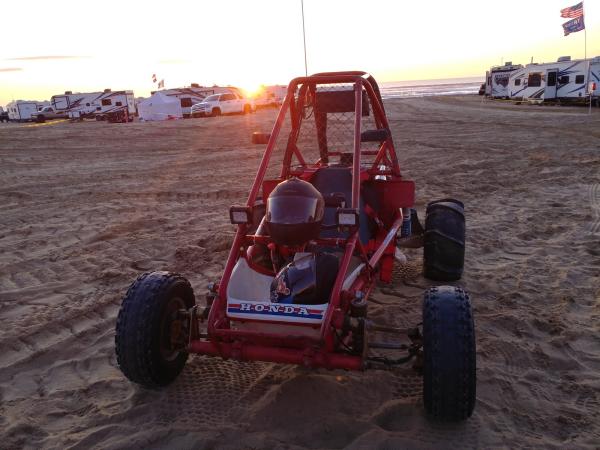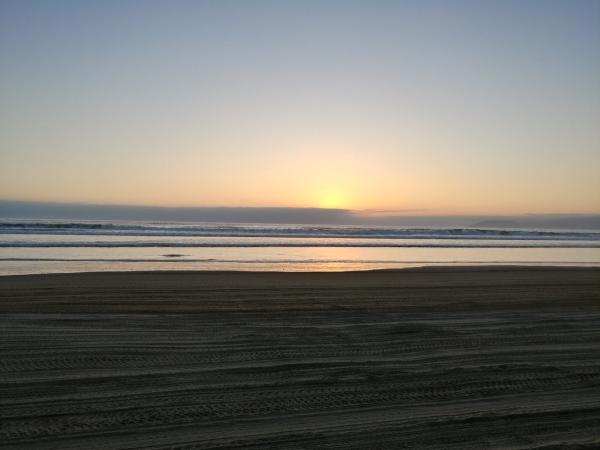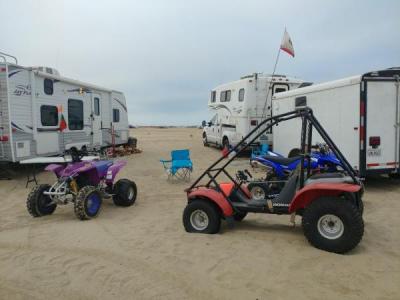The Honda Odyssey ATVs are unique machines—rare, ahead of their time, and an absolute thrill to ride. However, finding the perfect place to unleash their full potential can be challenging due to their specific design features. One of the best locations to experience the joy of riding these vintage ATVs is the Pismo Beach/Oceano Dunes SVRA in California. This guide will help you plan an unforgettable trip to the dunes, ensuring you and your Honda Odyssey have the best experience possible.
Step One: Find Friends to Join You
While you can venture to the dunes solo, going with friends enhances the experience for several reasons:
- Navigational Assistance: Reaching the campsites requires driving six miles on the beach. If you're unfamiliar with driving on sand, especially the soft sand near campsites, having friends with additional vehicles can be invaluable in case you get stuck.
- Safety in Numbers: The dunes cover a large area. During busy times, help is usually nearby if you encounter trouble. However, in quieter periods, some sections are remote. Having friends around increases safety and ensures assistance is readily available.
Step Two: Book Reservations Months in Advance
Oceano Dunes SVRA is extremely popular especially on weekends and Holidays. To secure a spot, especially during major holidays, you need to plan ahead:
- Advance Booking: Reservations open six months in advance. Mark your calendar and be prepared to book as soon as they become available.
- Peak Times: For holidays and summer weekends, reservations can fill up quickly—sometimes within hours of opening.
- Weekdays: If you plan to visit on weekdays, you might have more flexibility, but it's still wise to book a few weeks ahead.
Step Three: Know the Tide Schedule
Driving on the beach is a unique aspect of Pismo Beach camping:
- Low Tide Advantage: Aim to arrive just before low tide. The sand is harder and more compact, making it easier to drive without getting stuck.
- High Tide Challenges: Arriving at high tide means softer sand and a greater risk of getting stuck. Additionally, you'll have to navigate a seasonal creek that can be deeper during high tide.
- Tide Charts: Check local tide charts when planning your arrival and departure times.
Step Four: Pack Appropriately for the Trip
Camping on the dunes requires some special considerations:
- Vehicle Preparation:
- Paddle Tires: Highly recommended for your ATV to improve traction in the sand.
- Air Compressor: Useful for adjusting tire pressure when transitioning between sand and paved roads.
- Boards or Mats: Place them under your vehicle's wheels to prevent the wind from eroding the sand beneath and to aid in traction.
- Supplies:
- Extra Water: Essential for both you and your vehicle.
- Fuel: Bring enough fuel for your ATV, as trips into town can be time-consuming.
- Fire Pit: A gas fire pit is ideal, as it complies with local regulations and provides warmth and ambiance.
Step Five: Arrival
Timing your arrival is crucial:
- Optimal Arrival Time: Plan to arrive one to two hours before low tide.
- At the Entrance:
- Reservation Proof: Have your reservation details handy for the guard station to prevent traffic delays.
- Initial Driving: The sand near the entrance is usually hard-packed. You may not need to air down your tires immediately.
- Adjusting Tire Pressure:
- Low Tide: You might be able to drive the six miles to the camping area without reducing tire pressure.
- High Tide: If arriving during high tide, air down your tires as soon as you hit the beach to prevent getting stuck.
- Tire Pressure Guidelines:
- 4x4 Vehicles: Reduce to around 30 psi if lightly loaded.
- Heavily Loaded or 2WD Vehicles: You may need to go down to 15 psi or lower. For example, a 2WD Ford F350 dually with a camper and trailer might require 15 psi.
- Seasonal Creek Crossing: Be cautious of a creek that can be up to 2 feet deep during high tide. Crossing is safer and easier at low tide when it's only a few inches deep. Also, new rules have been put in place where the crossing will be closed if the combination of water flow and high tide causes the water to be over a certain depth.
Step Six: Find a Campsite
Finding the perfect campsite can set the tone for your entire trip:
- Arrival in Darkness: If you arrive after dark, locating a site can be challenging.
- Strategy:
- Drive to Mile Marker 3 or 4: This area is less crowded and away from heavy beach traffic.
- Note... Due to changes at the park, Mile Marker 4 is the last Marker you can now drive to. Marker 5 and 6 have been closed off for camping access. This condenses the camping space significantly so planning to go off peak season is important.
- Use a Scout: Unload an ATV and have someone scout ahead for suitable spots.
- Avoid Busy Areas: Steer clear of high-traffic zones near the beach and outhouses.
- Navigating Soft Sand:
- Air Down Tires: Ensure your vehicle's tires are adequately deflated for soft sand.
- Maintain Momentum: Keep a steady speed between 5 to 10 mph without flooring the accelerator.
- Smooth Turns: Make wide, gentle turns to avoid digging into the sand.
Step Seven: Choose Your Campsite Orientation
How you position your vehicle can impact your comfort:
- North/South Orientation:
- Advantages: Provides a windbreak on the leeward side for setting up camp.
- Considerations: Wind can erode sand under your vehicle; using boards can help prevent this.
- East-Facing Orientation:
- Advantages: Protects your vehicle's paint from sandblasting on windy days.
- Considerations: Less natural shelter from the wind for your campsite and potentially more challenging when departing uphill.
Step Eight: Park and Set Up Camp
After reaching your spot:
- If Stuck:
- Stay Calm: If you get stuck and it's late, consider staying put until morning.
- Safety First: Ensure you're not in a hazardous location, such as too close to the water.
- Night Arrivals:
- Limited Activities: Set up essential equipment and get some rest.
- Rinse Off Saltwater: If your vehicle was splashed, rinse it to prevent corrosion.
- Day Arrivals:
- Expect Noise: The dunes can be active until late at night, especially near popular riding areas.
- Relax: Enjoy a meal, sit by your gas fire pit, and prepare for the adventures ahead.
Conclusion
Embarking on a Honda Odyssey ATV adventure at Pismo Beach's Oceano Dunes SVRA offers an unparalleled experience filled with excitement, challenges, and unforgettable memories. By carefully planning your trip—gathering friends, booking reservations early, understanding the tides, and packing the right gear—you set the stage for a successful and enjoyable outing.
The dunes provide the perfect backdrop to unleash the full potential of your vintage ATV, allowing you to navigate open terrains and relish the freedom that comes with off-road exploration. While the journey may present obstacles, such as navigating soft sands and setting up camp in unique conditions, overcoming these challenges adds to the adventure and camaraderie of the experience.
So gear up, rally your friends, and embrace the thrill of riding your Honda Odyssey in one of the most scenic and dynamic environments available. With careful preparation and a spirit of adventure, your trip to Pismo Beach will not only meet but exceed your expectations, leaving you eager for the next dune escapade.
Happy riding, and see you on the dunes!


